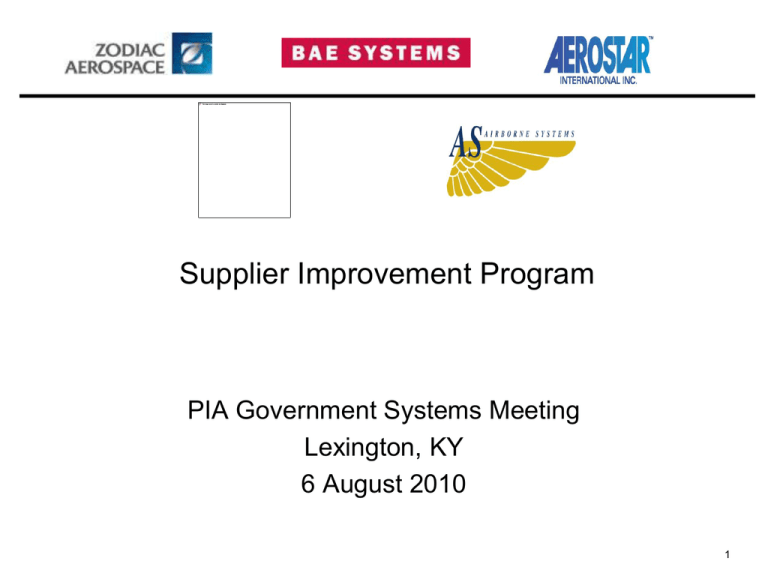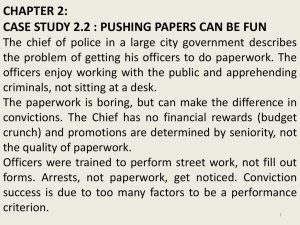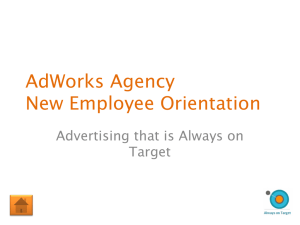Supplier Improvement Program - Parachute Industry Association
advertisement

Supplier Improvement Program PIA Government Systems Meeting Lexington, KY 6 August 2010 1 Outline • • • • • • • Team Origin Rules of Conduct Shared objectives Approach Data analysis Paperwork brainstorming Escalation plan – Phased approach – Description of phases • Implementation timeline 2 Team Origin • Originated out of PIA meeting inputs and discussions • Evidence of systemic non compliance to PIA/MIL specifications – Increased scrutiny by Government during First Articles and First Production Lots – Increased testing at receiving inspection – Common issues across supply base • Criticality of materials warrants focus and attention • Ability to improve communication between primes and suppliers • Desire of Primes to become more proactive and less reactive Suppliers execution critical to industry performance 3 Rules of Conduct • Treat each other fairly and with dignity • Keep our promises • Encourage cooperative efforts across the team, with each member having an equal voice • Work towards solutions that benefit both the group and your company • Do not engage in any activity that might create a conflict of interest for our company or for ourselves individually • Evaluations and discussion of supplier performance will be based upon factual data and audit findings 4 Shared Team Objectives • Enhance the performance of the Parachute Industry supply base – Improve both paperwork and material compliance to the specifications • Leverage our shared resources to address systemic or critical shared supplier issues • Strengthen communication of supplier related issues across the Parachute Industry – Between Primes and between suppliers • Identify issues proactively and work on preventive actions 5 Approach • Meet regularly via teleconference • Agree upon most significant supply chain issues facing the industry – Use data to guide decisions – Consider frequency, severity, and likelihood of detection • Establish prioritization (pareto principle) • Determine action plans for top one or two issues – Spread the actions across the team as much as possible • Document meeting with minutes and actions 6 Data Analysis • Reviewed each Prime’s rejections • Consistently saw same defect type as #1 • Became first focus of improvement initiative 7 BAE Inputs 80% of rejections for paperwork 8 Mills Manufacturing Inputs 42% of rejections for paperwork 9 Aerostar Inputs 65% of rejections for paperwork 10 Pioneer Inputs 70% of rejections for paperwork 11 Airborne Inputs Defect Types (Dec '09 to Present) 70 60 50 27% of rejections for paperwork 40 30 20 10 0 12 Paperwork Brainstorming Ideas • Conducted brainstorming session as a team on how to improve paperwork issues Option 1 - Create consistent graduated escalation stages for defective paperwork lots Option 2 - Implement common checklists for each supplier to submit Option 3 - Create common shared ‘web’ application where data is entered by suppliers and accessed by primes and customer • Team agreed on option 1 – – Option 2 complex, requiring extensive coordination between all primes and suppliers, also introduces new formats and requirements to suppliers Option 3 costly, complex and timely to implement as a solution does not exist in the software industry to date 13 Paperwork Improvement Phases 4th 3rd Defect 2nd Defect 1st Defect Defect Phase 4 Credit Withhold ($250) Phase 3 Delivery Release Phase 2 Corrective Actions 5 consecutive acceptable lots Phase 1 Notification Starting point 14 Paperwork Improvement Phase Details • All direction to be given through prime’s purchasing departments – Formal notification will be an introduction letter sent by each prime – Additional clause will be added to current/new purchase orders – Will apply to all suppliers of each prime • Escalation occurs at each prime independent of supplier activity at any other prime • Progress of suppliers that move into phase 2 and beyond will be shared across all primes • Removed from all phases once 5 consecutive lots are accepted with zero paperwork defects or 12 months (which ever comes first) 15 Phase Details • Phase 1 – Notification of first paperwork offense – Opportunity to ensure common understanding of expectations – Obtain concurrence with supplier on paperwork nonconformance • Phase 2 - Issuance of formal Corrective Action Request – Initiated upon second defective lot – Identical CAR form to be used by all primes, response requested in 14 days – Again confirm concurrence from supplier of paperwork nonconformance 16 Phase Details • Phase 3 - Delivery release program – Initiated after 3rd lot submitted with paperwork issues – Requires paperwork for each lot to be sent (electronically preferred) before shipment – Shipment of material does not occur until the paperwork is accepted by the prime – Primes agree to review and approve/reject with 72 hours • should be factored into delivery schedules 17 Phase Details • Phase 4 – Withhold cost of poor quality – Desire is to never get to this phase – Initiated after 4th lot submitted with paperwork issues – $250 to be withheld on invoice for only the rejected lot – Conservative estimate of $250 based upon additional labor to document the issue, communicate with the supplier, obtain approval, second review of data, segregation of material and closure of the disposition activity • Possibility exists for additional costs to be incurred as a result of the rejection and possibly passed along such as late shipment charges, OT required, line stoppage or difference in cost to procure replacement Objective = eliminate systemic paperwork issues! 18 Summary • Joint prime manufacturers team created to improve systemic supply base issues • Team using data to drive decisions • Data identified Paperwork as largest supply chain issue by frequency • Team jointly implementing Paperwork Improvement Program that has 4 phases SUPPLIER SUCCESS = INDUSTRY SUCCESS 19





